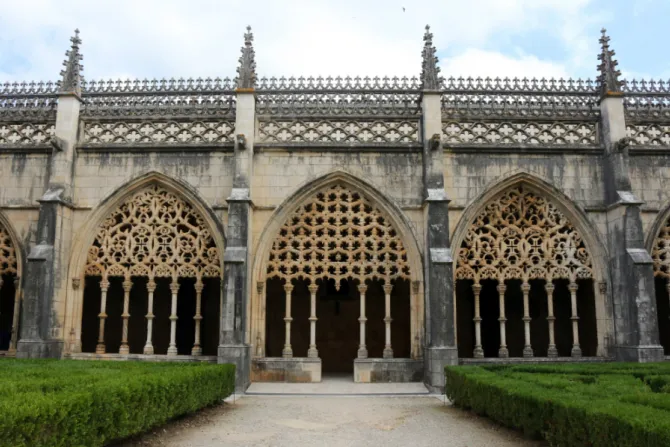Lisbon, Portugal, Dec 27, 2018 / 10:01 am
When the Virgin Mary appeared to three shepherd children in Fatima in 1917, Portugal had already acclaimed Mary as their reigning Queen for hundreds of years. After the coronation of Our Lady of the Immaculate Conception as "Queen of Portugal" by King João IV in 1646, no Portuguese monarch ever wore a crown again.
The history of exceptional Marian devotion near Fatima dates back even further.
Fourteen miles from the Fatima Shrine is the Batalha Monastery, where several dozen Dominican friars were commissioned in 1388 to pray a perpetual rosary in thanksgiving for the Virgin Mary's protection of Portugal.
The gothic monastery in Batalha was built in dedication to Our Lady of Victory in gratitude for an answered prayer. In 1385 King Joao I made a vow to the Virgin Mary that he would build a great monastery if she would deliver him victory in a battle against the Spanish.
The Dominican community remained in the monastery until 1834, when all religious orders were driven out of Portugal. Today it continues to function as both the local parish and a tourist attraction.
In nearby Alcobaca, a Cistercian monastery has stood in honor of Mary for over 800 years. The king of Portugal endowed the monastery to Saint Bernard of Clairvaux in 1153, shortly before the Cistercian founder's death. The gothic church was completed in 1223.
Benedict XVI has described Saint Bernard of Clairvaux as "a Doctor of Mariology" because "he understood her essential role in the Church, presenting her as the perfect model of the monastic life and of every other form of the Christian life."
An altarpiece in the Alcobaca Monastery, added in 1705, depicts the death of Saint Bernard under the protection of Mary. The walls in the monastery's King's Hall are decorated with 16th century blue and white rococo tile scenes depicting the history of the Cistercian order. An ornate oval baroque reliquary chapel containing 71 terracotta reliquary busts from floor to ceiling can be found in the sacristy. Napoleon's troops plundered the monastery in 1811, shortly before the Cistercians, like Batalha's Dominicans, were forced to leave Portugal.
Fewer than 10 miles from Alcobaca is the beachside town of Nazaré, named for a statue of the Virgin Mary brought from Nazareth by a monk in the 8th century, according to the local tradition.
Before Nazaré became a world-famous surfing destination with 80-foot waves, it was a popular medieval pilgrimage site. In 1182, a Portuguese knight was hunting a deer near the coast. When his horse nearly ran over one of Nazaré's steep cliffs, he called out "Our Lady, Help Me!" and his horse stopped just at the cliff's precipice next to the small grotto with the Nazareth statue.
In thanksgiving for his life, the knight had a small chapel built around the statue, which went on to receive so many visitors that a larger church dedicated to Our Lady of Nazaré was built near the cliffs by the King of Portugal in 1377 to house the statue and its pilgrims.
Despite the centuries-long tradition of Marian devotion in Portugal, when Our Lady of Fatima appeared in 1917, Catholics were not thriving in the country.
When the monarchy was abolished in 1910, the revolutionaries attempted to root out Catholicism and its Marian queen along with it, seizing all of the Church's property and assets. A popular illustration of the 1910 revolution includes an image of armed men marching out priests at gunpoint.
Anticlericalism peaked in the years leading up to the Fatima apparitions, causing the pope to speak out about the persecution of the Church under the First Portuguese Republic.
In 1911, Saint Pius X issued an encyclical, Iamdudum, decrying the secularization occuring in Portugal.
"We have seen, arising out of an obstinate determination to secularize every civil organization and to leave no trace of religion in the acts of common life, the deletion of the feast days of the Church from the number of public festivals, the abolition of religious oaths, the hasty establishment of the law of divorce and religious instruction banished from the public schools," wrote the pope.
(Story continues below)
St. Pius X's successor, Benedict XV, would go on to write a letter to his secretary of state for all the world's bishops on May 5, 1917 asking for prayers to the Virgin Mary for peace amid the ongoing devastation of World War I throughout Europe. In this letter, the pope made permanent an additional title for Mary in the Litany of Loreto: "Regina pacis," or "Queen of peace."
When Mary appeared in Portugal as Our Lady of the Rosary nine days later, she instructed, "Pray the Rosary every day, in order to obtain peace for the world and the end of the war." The Portuguese tradition of the perpetual rosary, dating back more than 500 years, would continue.
This article was originally published on CNA July 12, 2018.



